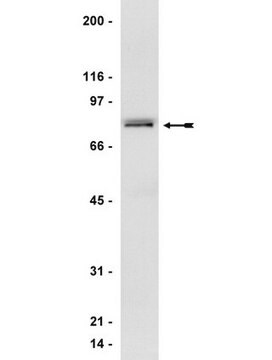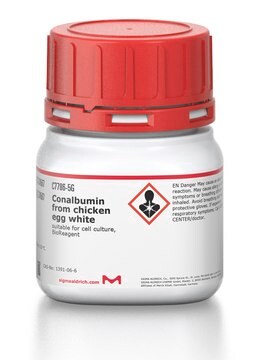G7670
Anti-GRK2 antibody, Mouse monoclonal
clone 3A10, purified from hybridoma cell culture
同義詞:
Anti-β-ARK1, Anti-BARK1, Anti-G Protein-dependent receptor kinase 2
登入查看組織和合約定價
全部照片(1)
About This Item
共軛:
unconjugated
application:
ARR
IP
WB
IP
WB
無性繁殖:
3A10, monoclonal
物種活性:
bovine, human, rat
citations:
8
技術:
immunoprecipitation (IP): suitable
microarray: suitable
western blot: 2-4 μg/mL using total cell extract from rat osteosarcoma (ROS)
microarray: suitable
western blot: 2-4 μg/mL using total cell extract from rat osteosarcoma (ROS)
推薦產品
生物源
mouse
共軛
unconjugated
抗體表格
purified from hybridoma cell culture
抗體產品種類
primary antibodies
無性繁殖
3A10, monoclonal
形狀
buffered aqueous solution
分子量
antigen ~65 kDa
物種活性
bovine, human, rat
技術
immunoprecipitation (IP): suitable
microarray: suitable
western blot: 2-4 μg/mL using total cell extract from rat osteosarcoma (ROS)
同型
IgG2b
運輸包裝
dry ice
儲存溫度
−20°C
目標翻譯後修改
unmodified
基因資訊
rat ... Adrbk1(25238)
一般說明
G protein-coupled receptor kinases (GRKs) protein family has 6 members, ranging from GRK1-GRK6.
Monoclonal Anti- GRK2/ARK1 (mouse IgG2b isotype) is derived from the hybridoma 3A10 produced by the fusion of mouse myeloma cells (SP2/0-Ag14 cells) and splenocytes from BALB/c mice immunized with recombinant bovine GRK2/ARK. G protein-coupled receptor kinases (GRKs) are important regulators of G protein-coupled receptors (GPCRs). GRK2, one of six members of this family that have been identified to date, is ubiquitously expressed in mammals. G-protein-coupled receptor kinase 2 (GRK2), which is officially known as adrenergic, , receptor kinase 1 (ADRBK1), gene codes for a 689 amino acid protein, that is of 79 kDa. This gene has 12 catalytic region subdomains. GRK2 is expressed in the vascular endothelium, arterial smooth muscle, myocardium, kidney and in the renal proximal tubule. It is mapped to human chromosome 11q13.
特異性
Monoclonal Anti-GRK2 antibody is specific for human, rat, and bovine GRK2/bARK1 (approx. 65 kDa). The antibody epitope is present within a highly conserved region of GRK2, ranging from residues 500-531. The product does not bind to other GRKs.
免疫原
recombinant bovine GRK2.
應用
Anti-GRK2 antibody, Mouse monoclonal has been used in:
- immunoblotting
- immunoprecipitation
- immunofluorescence staining
Monoclonal Anti-GRK2 antibody is suitable for use in western blot (2-4 μg/mL using total cell extract from rat osteosarcoma), microarray and immunoprecipitation.
生化/生理作用
G-protein-coupled receptor kinase 2 (GRK2) controls several intracellular mechanisms. It helps to maintain the structure and activities of the heart. Hence it participates in several cardiovascular diseases. GRK2 also modulates ion and fluid transport and eventually, blood pressure. It helps to enhance the production of mitochondrial superoxide and decreases oxygen utilization and ATP synthesis. This protein serves as a major oncomodulator. GRK2 regulates the level and rate of desensitization in GPCRs, and is also involved in cardiovascular pathologies and chemokine receptor modulations.
外觀
0.01M 磷酸缓冲盐溶液,pH 7.4,含 15mM 叠氮化钠。
免責聲明
Unless otherwise stated in our catalog or other company documentation accompanying the product(s), our products are intended for research use only and are not to be used for any other purpose, which includes but is not limited to, unauthorized commercial uses, in vitro diagnostic uses, ex vivo or in vivo therapeutic uses or any type of consumption or application to humans or animals.
未找到適合的產品?
試用我們的產品選擇工具.
儲存類別代碼
10 - Combustible liquids
水污染物質分類(WGK)
WGK 3
閃點(°F)
Not applicable
閃點(°C)
Not applicable
個人防護裝備
Eyeshields, Gloves, multi-purpose combination respirator cartridge (US)
Opsin 3 and 4 mediate light-induced pulmonary vasorelaxation that is potentiated by G protein-coupled receptor kinase 2 inhibition
Ortiz SB, et al.
American Journal of Physiology. Lung Cellular and Molecular Physiology (2018)
Kalpana Rajanala et al.
Molecular biology of the cell, 32(20), br2-br2 (2021-07-15)
Heterotrimeric G proteins (αβγ) function at the cytoplasmic surface of a cell's plasma membrane to transduce extracellular signals into cellular responses. However, numerous studies indicate that G proteins also play noncanonical roles at unique intracellular locations. Previous work has established
G protein-coupled receptor kinases: Crucial regulators of blood pressure
Yang J, et al.
Journal of the American Heart Association, 5(7), e003519-e003519 (2016)
G protein-coupled receptor kinase 2 (GRK2) promotes breast tumorigenesis through a HDAC6-Pin1 axis
Nogues LR, et al.
EBioMedicine, 13, 132-145 (2016)
G-protein-coupled receptor kinase 2 (GRK2) inhibitors: current trends and future perspectives
Guccione M, et al.
Journal of Medicinal Chemistry, 59(20), 9277-9294 (2016)
我們的科學家團隊在所有研究領域都有豐富的經驗,包括生命科學、材料科學、化學合成、色譜、分析等.
聯絡技術服務





